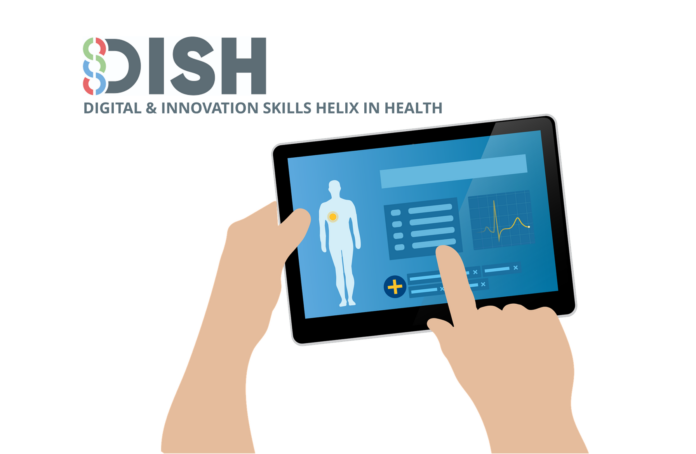
The various problems of the competencies of the healthcare personnel have been investigated in the phase of selection of the cases to be involved in the DISH project activities. This investigation aimed to identify healthcare units, where real-life problems existed, related to the digital transformation occurring in these units. It was a kind of learning process, in which not only different, specific competencies have been discussed, but also the various approaches to deal with the problem observed. The range of possible strategies started from actively facing the problem, then naming the needs and finally finding solutions, to staying passive and doing nothing with the view for problem self-resolution. Interestingly, the concept developed by the DISH consortium proved to be useful in all cases finally selected to participate in the program.
We have talked with Mr Bartosz Kosinski from “1+1 Social Cooperative”, who is responsible for the realisation of the training programs for the healthcare sector, to find out, how he perceives the concept and what he values most in the systematic approach offered.
Q: During the preparation and implementation, did you encounter any obstacles in the implementation of the training?
The biggest problems related to the consequences of the ongoing pandemic, some people were not interested in providing training in a stationary mode. Healthcare facilities functioned with great uncertainty as they were not sure to what extent they would be able to function even shortly due to the risk of suspending the activities of some departments.
Q: Was the concept easy to understand and implement?
The documentation was understandable. It made it possible to better structure the teaching process, paying attention to the goals and the method of verifying their achievement. It facilitated the planning process and, consequently, increased the effectiveness of the training.
Q: How in practice has it helped you as the training provider?
As mentioned earlier, the planning process was definitely facilitated, it allowed for a more thorough reflection and planning of the entire process, it also forced a more in-depth diagnosis of the needs of the training participants. Most important is that, based on the data collected from participants, the competencies transferred in the training program coincided with the expectations regarding digital transformation in their units.
Q: Why is this important?
The health service operates in a system of individual units, which must function in a coherent, uniform health care system. Thus, the level of digitization of a single facility affects the operation of the entire system. Thus, a certain standardization in the field of training increasing the competencies of healthcare workers is important. Due to the far-reaching digitization process of the healthcare system in Poland and Europe (as an example, e.g. the introduction and widespread use of the so-called Covid passports by various entities), the efficient operation of the healthcare system is and will be largely determined by the digital competences of employees. Hence, a project like DISH is needed, and perhaps even crucial, to the smooth functioning of the healthcare system.
Talking with program participants, we were also able to identify the key barriers lowering the effectiveness of the projects aimed at introducing new digital tools, thus changing internal processes and overall culture of work. For example, the most common challenge for managers was with choosing a training concept that would work and address all their doubts at the same time. Managers did not know how to deal with their problem, where to start, how to approach the problem. As a result, there was a lack of consistency in organizing training courses for all hospital employees, while they were facing growing requirements related to the digitization of healthcare.
The other issue is related to low digital competencies of the core staff, lack of staff dealing with e-administration and management of the electronic data exchange environment. It is partly the issue of insufficient experience of the hospital management in implementing e-health solutions. Almost nobody has ever been trained in these areas, instead, they acquired skills through experience. So far, very little attention has been put in improving employees’ e-skills. The implemented digital solutions were treated individually and most often contained only a user manual for selected digital solutions. Due to the developments and great improvements in digital technologies and requirements for the implementation of digital solutions in hospitals, in the opinion of the management, the systematic and well-organized implementation of appropriate solutions seemed to be of key importance.
Yet another issue is the reluctance of some hospital employees to technical innovations followed by a negative attitude of training participants to improve digital skills. The need of using new digital tools, and in generally speaking – the introduction of digital technologies is often associated with uncertainty and problems, especially for older personnel.
The only remedy to these problems seems to be in the education of the health care personnel targeted on a wide range of digital skills, offered as the lifelong learning process and promoted as the opportunity, not an obligation.
To make this strategy effective, a set of three tools have been developed to support a systemic approach:
1The set starts with the process tool aimed at setting up the scene for innovation-, technology-, competence and skills, that need to be discussed and planned to achieve shared understanding among those, who are directly and indirectly involved. This step is of critical importance to make a well-informed decision about the scope and depth of the training necessary. It will later facilitate the dialogue with the training provider as well as it will frame the expectations of the trainees.
2The second is a process tool for planning and delivery of the on-the-job training, aimed at equipping health care professionals with the right set of skills, which respects the above-mentioned planning. It means that the training program will not focus solely on skills but also on the preparation of the staff that will be trained and those who will passively assist – we have to bear in mind that we talk about “on-the-job-training”. Similarly, care is put into the delivery process to make it smooth and effective when delivered in a semi-natural environment.
3Finally, the third process tool helps planning and to carry out assessment and acknowledgement of the skills obtained. This process aims at closing the learning loop and in practice, it is the starting point of the next one.
In summary, the fully implemented concept offers to health care professionals a kind of experience that makes the digital transformation go more smoothly and in the direction that is expected and welcomed by all involved.
Klaster LifeScience Kraków był jedną z 6 instytucji biorących udział w projekcie DISH. Podsumowanie działań Klastra już 25 marca, w nadchodzącym wydarzeniu – „Kompetencje cyfrowe w medycynie – potrzeby i perspektywy”. Zapraszamy do udziału!

